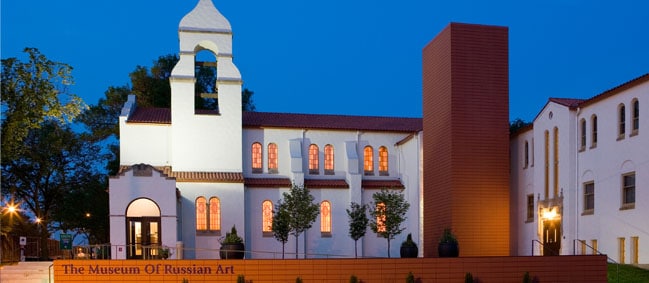The Museum of Russian Art in Minneapolis, Minnesota showcases a wide range of Russian Art, extending from print-making artifacts to 20th century painting and photography. Though The Museum of Russian Art originally focused on 19th and 20thcentury Russian artwork, the collection has expanded since its inception to encompass an extensive array of Russian artwork including Orthodox icons, Matryoshka dolls, Soviet stamps, textiles, photographs and printmaking artifacts. The museum is also frequently host to Russian musical performances and lectures on Russian art.
The museum really got its start in the mid-eighties when Raymond E. Johnson, previously having dealt primarily with American Realist paintings, decided to take his collection in a new direction. Physically, that direction was northeast, as he moved his business from Scottsdale, Arizona to Bloomington, Minnesota. Artistically, that direction was much farther east, to Russia.

There, change was rumbling in the Soviet apparatus: Gorbachev’s liberalizing Glasnost reforms were opening up Russia. By consequence, in the mid-1980s, Johnson was able to send a coalition of art experts and curators into Russia in order to survey the artistic landscape. Johnson and others were intent on exploring the erstwhile lost world of Russian art and soon Johnson’s idea for a new collection gained traction. Because of these artistic expeditions, in 1991 Johnson was able to hold the first known retail exhibition in North America of Russian Impressionist paintings.
The Museum of Russian Art in Minneapolis, Minnesota showcases a wide range of Russian Art, extending from print-making artifacts to 20th century painting and photography. Though The Museum of Russian Art originally focused on 19th and 20thcentury Russian artwork, the collection has expanded since its inception to encompass an extensive array of Russian artwork including Orthodox icons, Matryoshka dolls, Soviet stamps, textiles, photographs and printmaking artifacts. The museum is also frequently host to Russian musical performances and lectures on Russian art.
The museum really got its start in the mid-eighties when Raymond E. Johnson, previously having dealt primarily with American Realist paintings, decided to take his collection in a new direction. Physically, that direction was northeast, as he moved his business from Scottsdale, Arizona to Bloomington, Minnesota. Artistically, that direction was much farther east, to Russia.
Johnson’s museum moved from Bloomington, MN, to Minneapolis in 2005, where it now inhabits a beautiful, somewhat geographically-anomalous structure built in Spanish Colonial-Revival Style. The building went up in 1935, to replace the over-crowded Mayflower Congregational Church. It was designed to look somewhat like the Alamo because the Meckels, an influential family in the church, had become enamored with the southwestern architectural style. The architect, another influential local church-goer, was Carl Bard. The building was slightly altered for its present use as a world class art museum in 2004 by architect Julie Snow. Under her direction, a mezzanine and environmental controls were added, as were many stylistic flourishes to enhance the architectural character of the church.
Source Material From:







